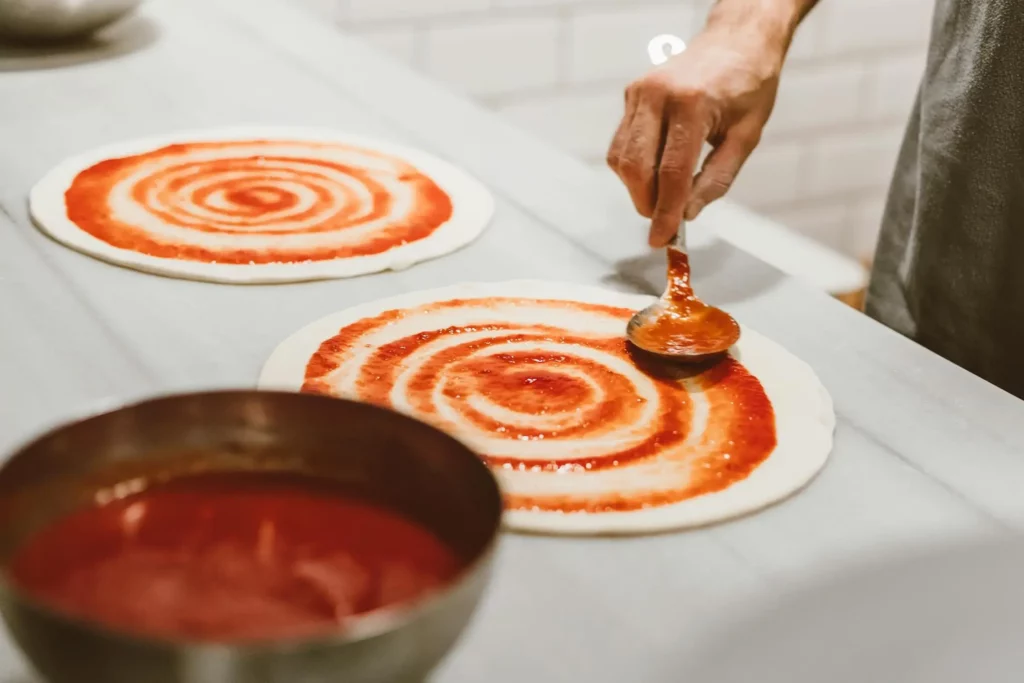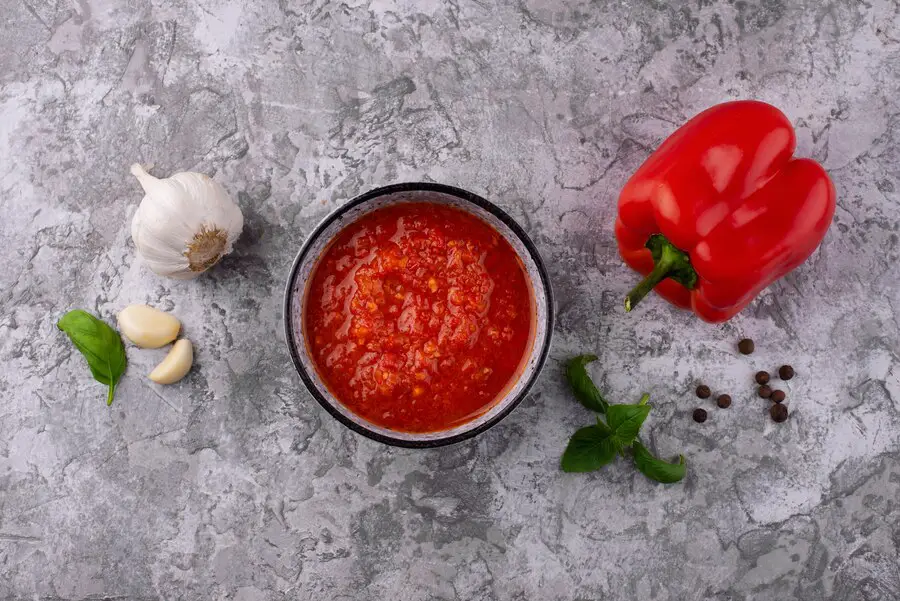In the culinary world, pasta sauce vs pizza sauce often command the center stage at mealtimes, captivating taste buds with their rich flavors and diverse textures. At the heart of their popularity lies the distinctive sauces that top them, each crafted with a unique blend of ingredients, cooking techniques, and intended uses. But how do pizza sauce and pasta sauce differ from one another?
Diving into the culinary arts, the distinction between pasta sauce vs pizza sauce is not as straightforward as it might initially appear. Yes, both sauces find their roots in the humble tomato, yet it is the subtleties in their composition and preparation that set them distinctly apart.
Join us as we explore the nuances that distinguish pasta sauce from pizza sauce, shedding light on the characteristics that make each sauce an essential element of its respective dish.
Table of Contents
ToggleWhat is Pasta Sauce?
Pasta sauce, in contrast, is a testament to culinary diversity and complexity. Unlike its pizza counterpart, pasta sauce is a more elaborate creation, often starting with a base of olive oil in which garlic and onions are sautéed to golden perfection. This foundation sets the stage for a rich tapestry of flavors, as tomatoes—be it in the form of fresh, canned, or tomato paste—are then introduced to the mix. The sauce may also be enriched with a variety of meats, from ground beef to Italian sausage, and even a medley of vegetables, each adding layers of depth and flavor.

The cooking process plays a pivotal role in the development of pasta sauce, allowing the flavors to intertwine and mature. A slow simmer ensures that the ingredients meld harmoniously, creating a sauce that’s not only thicker but also more nuanced in taste compared to pizza sauce. This cooked sauce clings to pasta beautifully, enveloping each noodle in a warm, savory embrace that’s distinctively different from the sharp, fresh zest of pizza sauce.
Marinara sauce, a type of pasta sauce, further exemplifies this diversity. Often considered a simpler cousin to more complex pasta sauces, marinara typically consists of tomatoes, garlic, onions, and herbs simmered to tender perfection. It shares some similarities with pizza sauce in its tomato-heavy base but is distinguished by its cooking process and the resulting depth of flavor.
Whether it’s the uncooked, herb-infused vibrancy of pizza sauce or the rich, slow-simmered complexity of pasta sauce, each brings its own unique character to the dishes they accompany. Understanding these nuances not only enhances the dining experience but also enriches one’s culinary repertoire, allowing for more informed choices in the kitchen.
What is Pizza Sauce?
Pizza sauce, with its gloriously straightforward and uncooked presentation, is a vibrant homage to the simplicity of Italian cooking. At its core, this sauce revels in the unadulterated purity of tomatoes, often utilizing a base of tomato paste or pureed tomatoes to achieve its signature consistency. The essence of pizza sauce is its freshness, achieved by foregoing the cooking process, allowing the dynamic flavors of the tomatoes to stand front and center. Seasoned liberally with herbs like oregano and basil, the sauce becomes a lively dance of flavors, each herb lending its distinctive note to the symphony.

The preparation of pizza sauce is a delicate balance, aiming to preserve the raw, tangy profile of the tomatoes while integrating the aromatic herbs. Unlike pasta sauce, there’s no simmering on the stove, no melding of flavors over heat. Instead, ingredients are combined in their raw state, sometimes with a dash of olive oil to tie the flavors together and add a smooth, rich texture that complements the crisp pizza crust. This method ensures the sauce remains light and zesty, with a texture that’s not too thick yet substantial enough to act as the perfect backdrop for toppings.
The use of tomato sauce and tomato paste provides the base for this sauce, offering a concentrated tomato flavor that’s both bold and straightforward. The choice between using sauce or paste can vary, with some chefs preferring the thicker, more intense flavor of paste, while others opt for the slightly more diluted and spreadable sauce. Regardless of the base, the goal is to achieve a perfect harmony between the tanginess of the tomatoes and the savory depth of the herbs.
In essence, pizza sauce is a celebration of minimalism and freshness. Its role is to enhance, not overpower, allowing the dough, cheese, and toppings to share in the culinary spotlight. This uncooked tomato sauce brings an element of brightness and acidity to the pizza, contrasting beautifully with the rich, melted cheese and the variety of toppings that might adorn the pie. It is this balance of simplicity and flavor that makes pizza sauce a crucial component of the pizza experience, offering a fresh burst of flavor with every bite.
Pasta Sauce vs Pizza Sauce: What’s the Difference?
1. Ingredients and Texture
The base for both sauces is tomatoes, but the similarity often ends there. Pizza sauce leans towards a thicker, paste-like consistency to prevent the pizza dough from becoming soggy. Pasta sauces, such as marinara or bolognese, contain more water and can include chunkier vegetable pieces or meat, offering a richer texture and flavor complexity.
Additionally, some pasta sauces incorporate ground beef or other meats, providing a richer flavor and texture that’s not commonly found in pizza sauce. Lastly, the adjustment of acidity with sugar is more prevalent in a pasta sauce to achieve a balanced taste profile, contrasting with the more straightforward, tangy quality sought in pizza sauce.
2. Cooking Process
One major difference lies in the cooking process. Pizza sauce, often made from crushed tomatoes and uncooked tomato sauce is spread raw on the pizza dough and cooks along with the pizza. This method preserves the tomatoes’ fresh, tangy flavor, ideally complementing the crispy crust and melted cheese. Conversely, pasta sauces are usually slow-simmered, allowing the flavors of the sauce’s components to meld together into a cohesive, rich taste experience.
3. Seasoning
One significant difference is the seasoning: pizza sauce often relies on a simpler herb profile, primarily oregano, and basil, to complement the dough and cheese. In contrast, pasta sauces, especially those like spaghetti sauce, might include a wider variety of herbs and even spices to match the broader range of pasta dishes they accompany.
4. Texture and Consistency
Another variation lies in the texture and consistency desired; pizza sauce is typically smoother and more concentrated, allowing it to spread evenly over dough without making it soggy, whereas a pasta sauce can range from finely pureed to chunky, offering a more substantial bite when mixed with noodles.
Pizza Sauce vs Marinara Sauce
A common question arises in the culinary world: How does marinara sauce fit into the comparison between pasta sauce and pizza sauce? Often, marinara is used interchangeably with pizza sauce in casual discussions, yet it stands firmly as a distinct type of pasta sauce in the gastronomic lexicon. Characterized by its straightforward recipe, marinara sauce boasts a foundation of tomatoes, garlic, herbs, and onions, embodying the essence of simplicity.

While it shares similarities with pizza sauce in terms of its tomato base and herbaceous seasonings, marinara distinguishes itself through its cooking process, resulting in a slightly chunkier texture that contrasts with the smooth, finely pureed consistency ideal for spreading atop pizza crusts. Additionally, marinara’s versatility extends beyond pasta, serving as a rich complement to a variety of dishes, which further underscores its distinct identity in the realm of tomato sauces.
Is Pizza Sauce the Same as Marinara?
While pizza sauce and marinara both celebrate the rich, tangy flavor of tomatoes, they diverge significantly in their intended culinary applications, preparation methods, and final textures. This distinction is crucial for both professional chefs and home cooks, guiding them in selecting the appropriate sauce to elevate their dishes.
Pizza sauce, with its raw, uncooked tomatoes blended with a harmony of herbs, is designed to meld with the dough and toppings under the high heat of an oven, creating a cohesive flavor profile. In contrast, marinara sauce undergoes a cooking process that not only thickens its texture but also deepens its flavors, making it a more suitable companion for pasta dishes or a hearty dipping sauce. Understanding these nuances ensures that each sauce is used to its full potential, enhancing the dining experience with authentic flavors and textures that pay homage to their roots.
How to Make Pizza Sauce
Ingredients
- 1 can (28 ounces) of premium San Marzano tomatoes
- 1-2 teaspoons of sea salt (adjust to taste)
- 2 tablespoons of extra virgin olive oil
- A handful of fresh basil leaves
- A few sprigs of fresh oregano (or 1 teaspoon dried oregano)
- Optional: a pinch of red pepper flakes for a bit of heat
Instructions
- Prepare Your Tomatoes: Begin by opening your can of San Marzano tomatoes. Pour the tomatoes into a large bowl and use your hands or a potato masher to crush them to your desired consistency. Some prefer a smoother sauce, while others enjoy a few chunky pieces for texture.
- Season the Pizza Sauce: To the crushed tomatoes, add 1-2 teaspoons of sea salt. Start with the lesser amount, and taste, and adjust according to your preference.
- Add Olive Oil: Pour in 2 tablespoons of extra virgin olive oil. This not only adds richness and depth to the sauce but also helps to carry the flavors of the herbs and tomatoes.
- Incorporate Fresh Herbs: Tear the fresh basil leaves and add them to the sauce. If you’re using fresh oregano, chop it finely before adding; if using dried, sprinkle it in. Fresh herbs add a vibrant, aromatic quality that elevates the sauce from good to great.
- Blend the Sauce (Optional): If you prefer a smoother sauce, use a blender or food processor to puree the sauce to your desired consistency. For a more authentic texture, skip this step and leave the sauce as is.
- Taste and Adjust: Give your sauce a taste test and adjust the seasoning if necessary. Remember, the flavors will concentrate slightly when baked on your pizza, so it’s okay if the sauce tastes a bit bold at this stage.
- Let It Rest: Allow your sauce to sit for at least 30 minutes before using. This resting period lets the flavors meld together, creating a more cohesive taste. For even better results, refrigerate the sauce overnight and use it the next day.
- Apply to Your Pizza Dough: When you’re ready to make pizza, spread a generous amount of sauce over your dough, leaving a small border around the edges. Then, add your favorite toppings.
- Bake: Cook your pizza in a preheated oven at the highest temperature possible (ideally between 475°F to 500°F) until the crust is golden and the cheese is bubbly.
- Enjoy: Remove your pizza from the oven, let it cool for a few minutes, then slice and enjoy the fruits of your labor.
Further reading: What is The Best Cheese for Pizza?: Selecting The Right Option
Can We Use Pasta Sauce for Pizza?
Indeed, you can transform pasta sauce into pizza sauce with just a few additional ingredients. By straining, blending, and seasoning pasta sauce, you can create a suitable alternative for pizza sauce using ingredients commonly found in your pantry.
What Alternatives Can Be Used in Place of Pizza Sauce?
While traditional pizza recipes typically call for red tomato-based pizza sauce, there are various alternatives you can experiment with. Some popular substitutes for pizza sauce include: Pesto, Ricotta Cheese, Barbecue Sauce, Ranch Dressing, Tapenade, Olive Oil and Garlic, Sweet Chili Sauce, Chimichurri Sauce, Balsamic Glaze, Alfredo Sauce, Buffalo Wing Sauce, and more
In conclusion, while pasta sauce vs pizza sauce may share a common ancestor, the divergence in their preparation, ingredients, and application highlights the richness and diversity of these cuisines. Whether you opt for the fresh, tangy bite of pizza sauce or the deep, complex flavors of a cooked pasta sauce, each has its place in the kitchen. So, can pasta sauce serve as pizza sauce? Yes, with a few modifications. Regardless of the pizza variations you wish to create, refining your pizza sauce recipe is crucial for delivering an exceptional dining experience and cultivating loyal customers.






